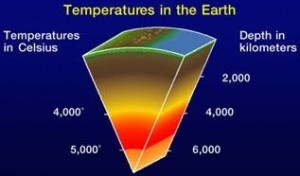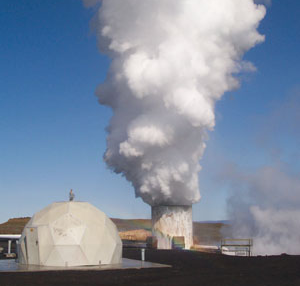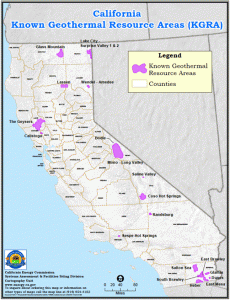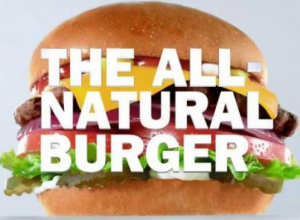March 2015 – Volume 16, Issue 10: The Stepchild Geothermal
IN THIS ISSUE
Flanigan’s Eco-Logic
Three Types of Geothermal Energy
Reader Response
The World’s Largest Offshore Wind Farm
Apple’s Solar Procurement
The EPA’s Clean Power Plan
Chewing Gum in Scope
Wind Turbines for the Eiffel Tower

Flanigan’s Eco-Logic: The Stepchild Geothermal
Some years ago EcoMotion visited Iceland to fully explore its great geothermal leadership. Amazing. We were there with Palm Desert councilmembers keen on energy independence. The trip left us with the great sense that you can indeed take a healthy dependency (read: addiction) to fossil fuels, eliminate it, and turn its clean-tech replacement into perhaps the most profitable aspect of the Icelandic economy. There’s lots to be learned from the Iceland case study. I’ve written about it and lectured on it many times, using it as a source of inspiration that it certainly has been for me.
We focus on the Icelandic notion of zero waste in geothermal production and use. The Minister makes an analogy. “Like eating an animal, out of respect for it, you eat and use the whole thing. This goes for power plants too.” I remember the Lindal diagram. In Iceland, declining geothermal water temperatures are used for a number of applications – from power generation, to industrial uses, district heating, snow melting, fish drying, aquaculture of Senegal Soul, and finally warming the water at Nautholsvik Beach for swimming in the frigid Northern Atlantic!
In the 1970s, as the Minister described, Iceland was given a gift… high oil prices. Yes, a gift, and one we’ve never received. This caused the country to re-examine its energy dependence, and ultimately to retool its society around its geothermal natural resource. Today, 90% of all homes in Iceland are heated with geothermal, another 9% with renewably generated electricity. And today, Reykjavik – once among the world’s most polluted cities – is now among the cleanest. Icelanders deserve to be proud.
The reception in LA was thematic: In 2001, Iceland and Governor Gray Davis’ administration signed a Memorandum of Understanding to promote geothermal. The MOU was between the California Technology, Trade and Commerce Agency and the Iceland Ministries of Energy and Commerce, “to jointly promote and participate in developing environmentally sound energy resources throughout California….” Our hosts, former Davis administration officials, lament that not much has happened. So is the time right now? And if so, can we hit the “re-start button” on viable collaboration?
“Quote of the Week”
“In the 1970s, Iceland was given a gift…high oil prices.”
Three Types of Geothermal Energy
Geothermal energy suffers from a lack of understanding… limited public awareness and appreciation of its force. What force? It’s the force, “the energy under our feet.” Geologists say that it’s just a matter of how far down you go. Although areas with telltale signs like hot springs are more obvious and are often the first places geothermal resources are used, the heat of the earth is available everywhere and can be used in a variety of ways.
Geothermal is considered a renewable resource because the heat emanating from the interior of the Earth is essentially limitless. According to the Geothermal Energy Association, the heat is estimated to be equivalent to 42 million megawatts (MW) of power, and is expected to remain so for billions of years to come, ensuring an inexhaustible supply of energy.
All forms of geothermal get heat from the Earth’s mantle. Where the mantle and the crust come together, the boundary, the molten materials is 7200 degrees F. From there, the “geo gradient” of the temperature decreases as it rises towards and reaches the surface of the Earth.
This article focuses on three forms of geothermal energy: Direct Heating, Power Production, and Geothermal Heat Pumps.
 Direct Heating: Historically, geothermal has been relegated tectonic plate boundaries. These areas are noted for their hot springs where hot water bubbles up at up to 700 degrees F. Bathing in hot springs has been going on since Paleolithic times. Geothermal energy has been tapped for space heating purposes since the ancient Roman times. This form of geothermal is also called “direct heating” as the geothermal fluids and steam has been used for spas, snow melting, fish drying and more.
Direct Heating: Historically, geothermal has been relegated tectonic plate boundaries. These areas are noted for their hot springs where hot water bubbles up at up to 700 degrees F. Bathing in hot springs has been going on since Paleolithic times. Geothermal energy has been tapped for space heating purposes since the ancient Roman times. This form of geothermal is also called “direct heating” as the geothermal fluids and steam has been used for spas, snow melting, fish drying and more.
Geothermal waters have long been revered for their healing qualities. The Romans used geothermal water to treat eye and skin disease and, at Pompeii, to heat buildings. Medieval wars were even fought over lands with hot springs. The first known “health spa” was established in 1326 in Belgium at natural hot springs. And for hundreds of years, Tuscany in Central Italy has produced vegetables in the winter from fields heated by natural steam.
The first geothermal district heating system in the world was commissioned in 1892 in Boise, Idaho at a spot where Native Americans used to congregate. Later the hot springs were used by settlers, miners, and trappers. The Boise geothermal system is still in use and has been joined by three more district heating systems. In 1973, Leo Ray first used geothermal water to raise catfish in Idaho. Currently, 12 aquaculture businesses are operating in Idaho raising tilapia, catfish, sturgeon, ornamental fish, and alligators.
Iceland began to heat homes with geothermal in 1943 and today is unparalleled in its widespread adoption and success. Worldwide there is some 28 GW equivalent for direct geothermal heating. That’s more than double the geothermal power production capacity.

Geothermal borehole in Iceland
Power Production: Today geothermal may be best known for electric power production. Geothermal plants use hot water to create steam to drive turbines. In 1960, Pacific Gas & Electric tapped the Geysers in Northern California. Today there are 21 geothermal power plants there. Worldwide there was 11,700 MW of this form of geothermal energy installed by the end of 2013. The International Geothermal Association reports that 10,715 geothermal power plants operate in 24 countries.
Today the U.S. is number one in geothermal power production, with 77 plants and 3,086 MW of capacity, and 29% of total worldwide geothermal power production. The U.S. is followed by the Philippines (1,904 MW), Indonesia (1,197 MW), Mexico (958 MW), Italy (834 MW), New Zealand (628 MW), Iceland (575 MW, and 5% of the global total), and Japan (536 MW).
Geothermal now generates 6% of California’s electricity production, with room for lots more. Given its location on the Pacific Ring of Fire, the State has 25 Known Geothermal Resource Areas (KGRAs)… 14 with temperatures in excess of 300 degrees F. These range from the Salton Sea in Imperial County, to Coso Hot Springs in Inyo County, and Mammoth Lakes in Mono County.
Geothermal power production is still largely untapped in California. And it has significant merits: Unlike other sources of renewables that are intermittent – geothermal plants can be configured to be baseload or peaking plants to provide the greatest value to the grid. New drilling technologies have expanded the potential for geothermal.
 Geothermal Heat Pumps: A third form of geothermal that has been gaining in popularity and application are geothermal heat pumps for heating homes and buildings. Geothermal heat pumps are electrically powered systems. Loops run in the ground and collect its warmth. They can also be used for cooling in summer months and can be configured to supply domestic hot water too.
Geothermal Heat Pumps: A third form of geothermal that has been gaining in popularity and application are geothermal heat pumps for heating homes and buildings. Geothermal heat pumps are electrically powered systems. Loops run in the ground and collect its warmth. They can also be used for cooling in summer months and can be configured to supply domestic hot water too.
Geothermal heat pumps have been in use since the late 1940s. They use the constant temperature of the earth as the exchange medium instead of the outside air temperature. Animals burrow underground for warmth in the winter and to escape the heat of the summer. The same idea is applied to geothermal heat pumps.
Although many parts of the country experience seasonal temperature extremes — from scorching heat in the summer to sub-zero cold in the winter-a few feet below the Earth’s surface the ground remains at a relatively constant temperature, 45°F to 75°F depending on your latitude. Like a cave, this ground temperature is warmer than the air above it during the winter and cooler than the air in the summer.
Heat pumps work much like refrigerators, which make a cool place cooler by transferring heat to a relatively warm place (the surrounding room), making it warmer. In the winter, the heat pump moves heat from the ground to the building’s interior. In the summer, the process is reversed, and the heat pump moves heat from the indoor air the ground. The heat removed from the indoor air during the summer provides a free source of hot water.
Reader Response: “All Natural, My Foot!”
 Hey Ted – I decided to comment on the Carl’s Jr. All-Natural Burger. The critics are right that All-Natural doesn’t mean healthy. Not only does that sandwich pack 760 calories and 44 grams of fat, but it also is neither organic nor vegetarian. The ‘all-natural’ label really means very little
Hey Ted – I decided to comment on the Carl’s Jr. All-Natural Burger. The critics are right that All-Natural doesn’t mean healthy. Not only does that sandwich pack 760 calories and 44 grams of fat, but it also is neither organic nor vegetarian. The ‘all-natural’ label really means very little
Since this is still beef, there are still all the things associated with it, including global warming, for instance. Here’s a quote from the February 2009 issue of Scientific American, “The FAO report found that current production levels of meat contribute between 14 and 22 percent of the 36 billion tons of “CO2-equivalent” greenhouse gases the world produces every year.”
Then, of course, there is the organic issue. Since all-natural does not mean organic, therefore this beef was likely fed GMO feed that had mega-doses of herbicides and pesticides used in its production (with all the water run-off of them). They likely were also fed chemical based fertilizers that are petrochemical products, and have the water run-off as well.
The all-natural label is a scam, created by the non-organic industry to convince the public that they are consuming something superior, will pay more for it, and are really still causing serious health and environmental harm.
I just took a look at Nolan Ryan’s All Natural Beef website, where he brags that his all natural beef isn’t given hormones less than 100 days before “harvest.” I never heard of “harvesting” cattle! And, that they are tested for pesticide residue. So, he basically states that they use hormones and they use pesticides, but none of it is detectable in the cattle they sell using the tests that they perform. It would be great if they would also test the ground water, the local streams and lakes, the local population, the farm workers, etc.
George Reis, Santa Ana
The World’s Largest Offshore Wind Farm

Location of the Dogger Bank
The United Kingdom currently has about 1,200 offshore wind turbines, with a total generating capacity of about 4 gigawatts. That’s the capacity of four large nuclear reactors. Now there are plans to build the world’s biggest offshore windfarm 80 miles off the Yorkshire coast on the Dogger Bank, an array of up to 400 turbines with a built-out capacity of 2,400 MW. The project, more than twice the size of the UK’s current biggest offshore windfarm, is expected to cost $9 – 12 billion USD. When fully developed, it could provide 2.5% of the UK’s electricity needs.
The Dogger Bank has been considered for offshore windfarms for some time because the shallow seabed, it’s only about 100 feet deep, making it easier to lay foundations and construct large turbines. So far, no company has yet ventured into the area. Director of Offshore Renewables at Renewable UK, the wind industry association, said that, “Dogger Bank demonstrates the sheer potential of offshore technology to turn our vast ocean and wind resources into green energy.”
Construction of the first turbines could still be years away. The Forewind consortium which is behind the project is made up of Scottish and Southern Energy, Germany’s RWE, and Norway’s Statoil and Statkraft, the former the country’s majority state-owned oil business and the latter its state-owned electricity company. About $90 million has been spent by the companies so far on surveys alone.
The UK’s last biggest offshore wind site, the London Array, ran into difficulties soon after gaining the government’s green light in a long drawn-out process from 2005 to 2007. Costs spiraled, some investors withdrew backing, but the 175 turbine wind farm was inaugurated in 2013. The British wind industry now supports 35,400 jobs, with $22 billion USD invested in wind there since 2010.
Apple’s Solar Procurement

Apple HQ, Cupertino, CA
A year ago Apple Chief Executive Officer Tim Cook responded to a climate-change heckler at the company’s annual shareholder meeting with an impassioned rebuttal in which he famously told investors who care only about profits to “get out of the stock.” He was adamant that Apple would be a good corporate citizen.
Now Cook’s Apple has announced an $850 million agreement to buy solar power from First Solar, the biggest U.S. developer of solar farms. The deal will supply enough electricity to power all of Apple’s California stores, offices, headquarters and a data center. It’s the biggest-ever solar procurement deal for a company that isn’t a utility, and it nearly triples Apple’s stake in solar.
Bloomberg News reports that the deal will provide Apple with 130 megawatts of solar capacity for 25 years. The solar power will be generated at First Solar’s 2,900-acre California Flats Solar Project in Monterey County. The project will be complete before the end of 2016 to take advantage of the 30% investment tax credit.
The agreement positions the CEO of the world’s biggest company at the center of the global debate about climate change and the future of energy. The company has been ramping up its investment in solar, with two 20 MW plants completed and a third under development in North Carolina, and a 20 MW plant in development in Reno, Nevada. All of Apple’s data centers are now powered by renewables.

A First Solar installation in Topaz, CA
According to Cook, the First Solar deal is also a good business deal. “We expect to have very significant savings,” he said. As if to underline that fact, within minutes of announcing the solar deal, Apple’s stock ended the trading day with a record valuation of $711 billion, making it the first U.S. company to cross the $700 billion mark. Shares of First Solar also surged.
Apple is not alone in solar procurements: Last year Google signed a 400 MW power purchase agreement for wind power, bringing its corporate total to 1 gigawatt. In the past two years, Microsoft has entered into deals for 285 MW of wind, including one of the world’s biggest contracts for a single facility. Last month Amazon jumped into the race, signing a 150 MW wind agreement. In September, Ikea committed to becoming 100% renewable by 2020. The furniture retailer already gets a significant amount of its power through company-owned wind projects worldwide. And then Wal-Mart now has more than 100 MW of distributed generation installed.
The EPA’s Clean Power Plan
 Power plants are the largest source of carbon pollution in the U.S., Power plants account for nearly 40% of all U.S. carbon dioxide emissions. That’s more than every car, truck, and plane in the U.S. combined.
Power plants are the largest source of carbon pollution in the U.S., Power plants account for nearly 40% of all U.S. carbon dioxide emissions. That’s more than every car, truck, and plane in the U.S. combined.
On June 2, 2014, the U.S. Environmental Protection Agency, under President Obama’s Climate Action Plan, proposed a plan to cut carbon pollution from power plants. The Clean Power Plan is intended to maintain an affordable, reliable energy system, while cutting pollution and protecting our health and environment. The rules are expected to be finalized in June, 2015.
Although there are limits at power plants for other pollutants like arsenic and mercury, there are currently no national limits on carbon. Now, for the first time, the EPA is developing new rules that will reduce carbon emissions from power plants. These standards, known as the Clean Power Plan, are being developed under the Clean Air Act, an act of Congress that requires the EPA to take steps to reduce air pollution that harms the public’s health. The Clean Power Plan will guide carbon dioxide emissions reductions in the power sector by 30% from 2005 levels.
The Clean Power Plan puts states “in the driver’s seat” to a cleaner, more efficient power fleet of the future by giving them the flexibility to choose how to meet state-by-state carbon emissions rate reduction targets. Targets differ across states because of each state’s unique mix of electricity-generation resources-and also because of technological feasibilities, costs, and emissions reduction potentials of each building block, all of which vary across the country.
The Plan provides for a number of options to cut carbon emissions-called “building blocks”-and determines state emissions rate targets by estimating the extent to which states can take advantage of each of them. Building blocks include renewable energy resources, nuclear power, efficiency improvements at individual fossil fuel plants, shifting generation from coal to natural gas, and greater energy efficiency in buildings and industries. States can combine building blocks to meet their targets. They can also join multi-state and regional compacts to tap least-cost, carbon mitigation options.
Chewing Gum in Scope

Adams chewing gum ad
Whether it’s being used as a mid-day breath refresher or on the playground to see who can blow the biggest bubble – chewing gum is a daily habit for many people. In fact, chewing gum is the most popular snack in America. The average one of us chews 300 sticks per year. And there are benefits, from increased saliva production to fewer cavities and increased mental attention. Chewing gum while peeling onions will keep you from crying. But what the heck are we chewing?
Gums began as natural substances. They can be traced back to ancient Greece, an edible treat from the mastiche tree. The first gum factory was in the United States and was owned by Thomas Adams in the 1870s. Its product was based on a substance from the sapodilla tree. Adams was trying to make tires, and ended up with an edible product after adding sugar. Later natural materials were replaced with synthetic polymers that do not dissolve in water, or even when exposed to stomach acids.
There are three main ingredients in common gum: a “gum base,” sweeteners, and artificial flavorings. Gum bases are made of various combinations of polymers, resins, and waxes. FDA allows conventional gum brands to hide up to 80 synthetic ingredients in a catch-all term “gum-based” on the label. This may be a case where you really don’t want to know what you are chewing.
So organic chewing gums to the rescue! Simple Gum is 100% natural, hand-crafted in New York, and is based on the chicle tree. Another product, Chicza, comes from the Mayan rainforest. The Chicle tree’s polyisoprenes are easily biodegraded.
Back to the common gum. What happens when you’re done chewing it? Chewing gum experts report that 80-90% of chewing gum is not disposed of properly. It’s the second most common form of litter after cigarette butts. And since the vast, vast majority of chewing gum is made from synthetic plastic polymers that do not biodegrade, when it lands on the sidewalk, it sits there for a very, very long time. In other instances it grows old on the undersides of dining room tables.
Micro Wind Turbines for the Eiffel Tower

Photo: AP
The Eiffel Tower gets seven million visitors each year. Last fall, the iconic structure completed its most ambitious makeover in 30 years, a makeover that included green features and two micro wind turbines. The two turbines generate enough electricity to power all of the Tower’s commercial areas.
Ever since its debut at the 1899 World’s Fair, the Eiffel Tower has provided an inspiration for builders to reach for the skies. Now the Société d’Exploitation de la Tour Eiffel, the authority responsible for managing the Eiffel Tower, had focused on going green in accord with the City of Paris Climate Plan. Green elements include new window glazing and new heat pumps for cool-weather warming. LED lighting is installed throughout, and a new solar array provides about half of the hot water needed by the two public pavilions. A rainwater harvesting system shunts flushing water to the restrooms.
The wind turbines are the VisionAIR5 model micro wind turbines made by Urban Green Energy (UGE). Together they are capable of generating 10,000 kWh annually. They are fastened inside the Tower about 400 feet above ground level. UGE custom-painted the installation to blend in with the structure. Incidentally, the Eiffel Tower is still in service as a broadcast tower, so pulling double duty as a wind energy generator is in keeping with its history as technology workhorse as well as a tourist destination.
